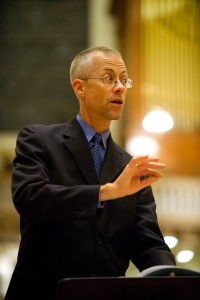
Blue Heron at Corpus Christi Church
By Christian Carey
NEW YORK – On December 18th, Boston-based early music ensemble Blue Heron appeared at Corpus Christi Church as part of Music Before 1800’s series there. Their program, titled “Christmas at the Courts of 15th century France and Burgundy,” featured polyphony and plainchant that celebrated the Advent and Christmas seasons. Led by Scott Metcalfe, the fifteen-person ensemble was frequently broken into subsets and often sang without use of a conductor. Metcalfe instead led much of the proceedings from behind a harp or alongside the singers, setting the pace in alternatim hymn settings by Guilliame Du Fay, antiphonal pieces with a large group of unison singers and a smaller group of soloists.
The first half of the concert featured music based on the O Antiphons, a collection of eight melodies that fall in the liturgical calendar as the chants that lead us from Advent to Christmas. Each verse of the famous hymn “O Come, O Come Emmanuel” features text from one of these antiphons. The polyphonic pieces that followed the chants employed material associated with the O Antiphons. Jacob Obrecht’s Factor Orbis quoted two antiphons, as well as a plethora of other texts and tunes, including a secular one bound to please the composer’s patron. Josquin Desprez’s O Virgo Virginum setting focused on just one antiphon, the eponymous eighth chant reserved for Christmas Eve in the Medieval Church (most denominations have since winnowed the number of O Antiphons from eight to seven in their respective liturgies). A six-part motet, O Virgo Virginum features stirring antiphonal passages for two trios and a veritable tapestry of interwoven short melodic motifs sung against the chant. Ave Maria gratia plena, by Antoine Brumel, was sung by three of the women of Blue Heron, providing an attractive timbral contrast to the preceding male-dominated selections.
In the Christmas section of the concert, split among the two halves of the program, the five-voice motet O admirabile commercium/Verbum caro factus est by Johannes Regis served as a centerpiece, with two other pieces that emulated it presented as well: the aforementioned Obrecht motet, and Brumel’s Nato canunt omnia. Like Factor Orbis, the other two motets featured multiple texts, chants, and interwoven melodies. Blue Heron presented these mélanges of material with enviable skill, allowing the complex counterpoint to come through with abundant clarity.

Photo: Liz Linder.
To celebrate New Year’s Day, nobles from Fifteenth century French and Burgundian courts exchanged lavish presents, including commissioned vocal works. In a section spotlighting these gifts, called estraines, the audience was treated to an assortment of chansons by Dufay, Nicholas Grenon, Guilliame Malbeque, Baude Cordier, Johanna Tinctoris, and Gilles Binchois. For these selections, instrumentalists joined Blue Heron: Metcalfe playing harp, Laura Jeppesen vielle and rebec, and Charles Weaver lute. The variety of textures obtained by the various ensemble groupings in this section of the program was lavishly multifaceted.
Likely the earliest of the selections on the program (apart from the encore), Johannes Ciconia’s Gloria Spiritus et alme was redolent in Lydian cadences. The resulting raised fourths and heightened sense of dissonance gave Blue Heron the opportunity to show off their use of just intonation in particularly splendorous fashion. Chords shimmered and melodic lines underscored the slightly unequal nature of the temperament’s half steps. It made for an extraordinary sound world. On the other end of the chronological spectrum, Adrian Willaert’s Sixteenth century motet Praeter rerum seriem featured seven-voice counterpoint. The thickened textures contained chant in a three-voice canon and sumptuous doublings of chord tones from the other four voices. The performance was truly transportative. As Metcalfe’s informative program notes pointed out, the piece’s seven-voice texture had another component of showmanship besides the obvious requisite compositional virtuosity: it contains one more voice than Josquin’s motet on the same text.
The concert ended with an encore from the Fourteenth century: Laudemus cum Armonia. The entire cohort of musicians raised their voices in song, making a most thrilling sound. It was an impressive end to a superlative performance.
_________
The next concert on Music Before 1800’s series is on Sunday, January 15, 2017 at 4 PM, when baritone Jesse Blumberg joins instrumental ensemble ACRONYM in a program devoted to music by Johann Rosenmüller. Blue Heron returns to Corpus Christi on October first: the week before my birthday. I certainly plan to make it my business to hear them again.
